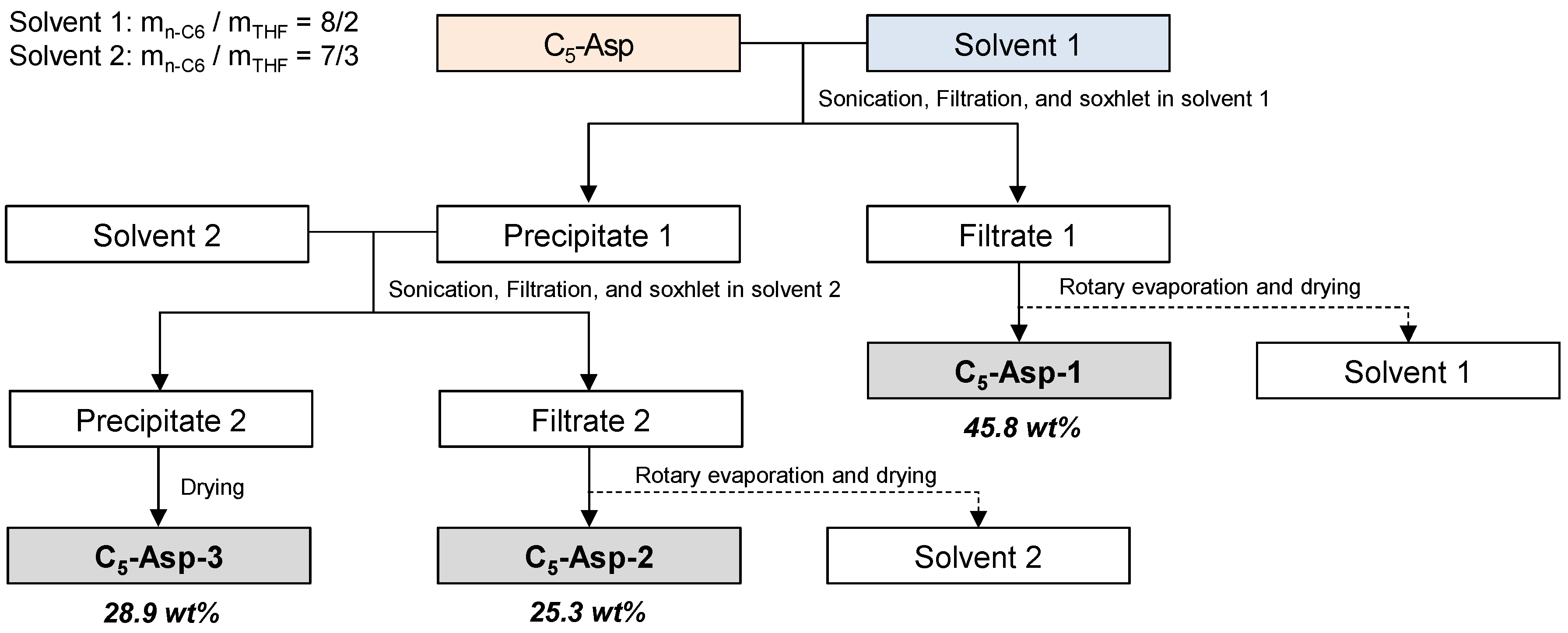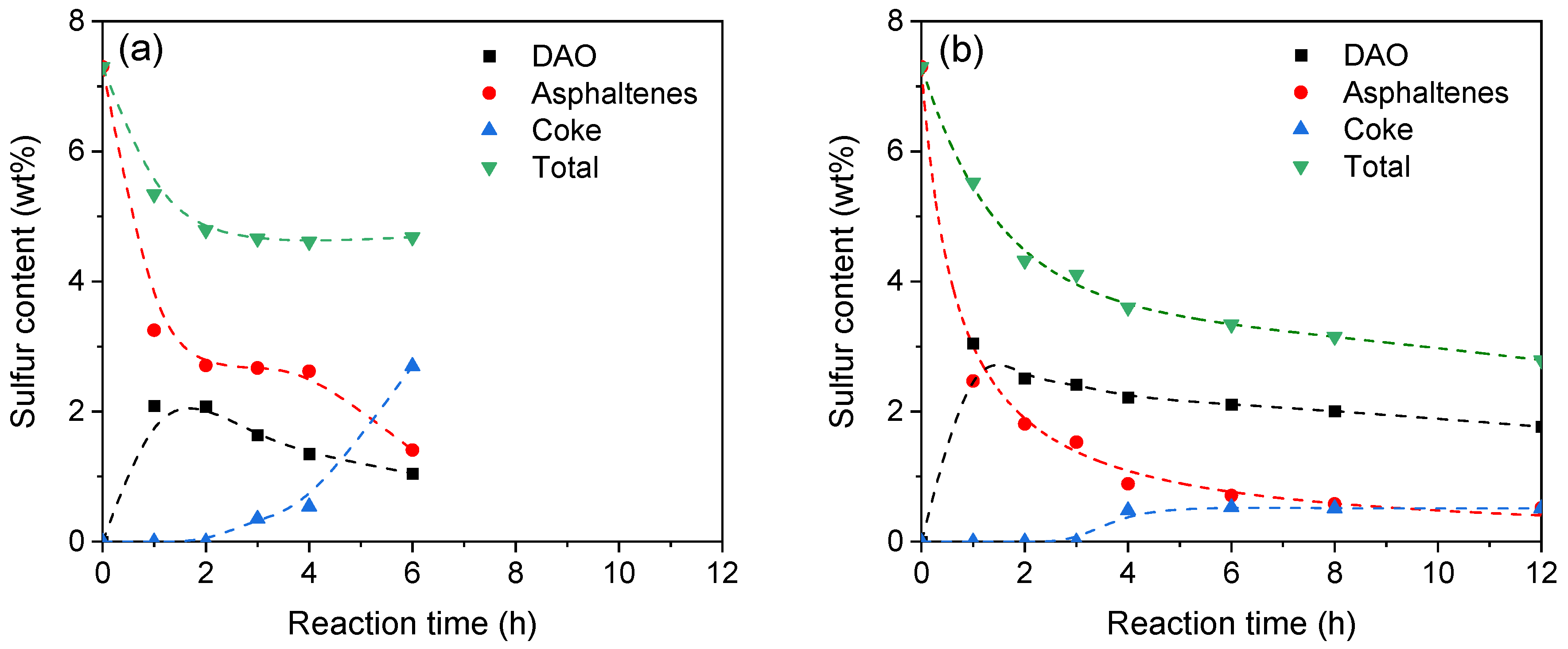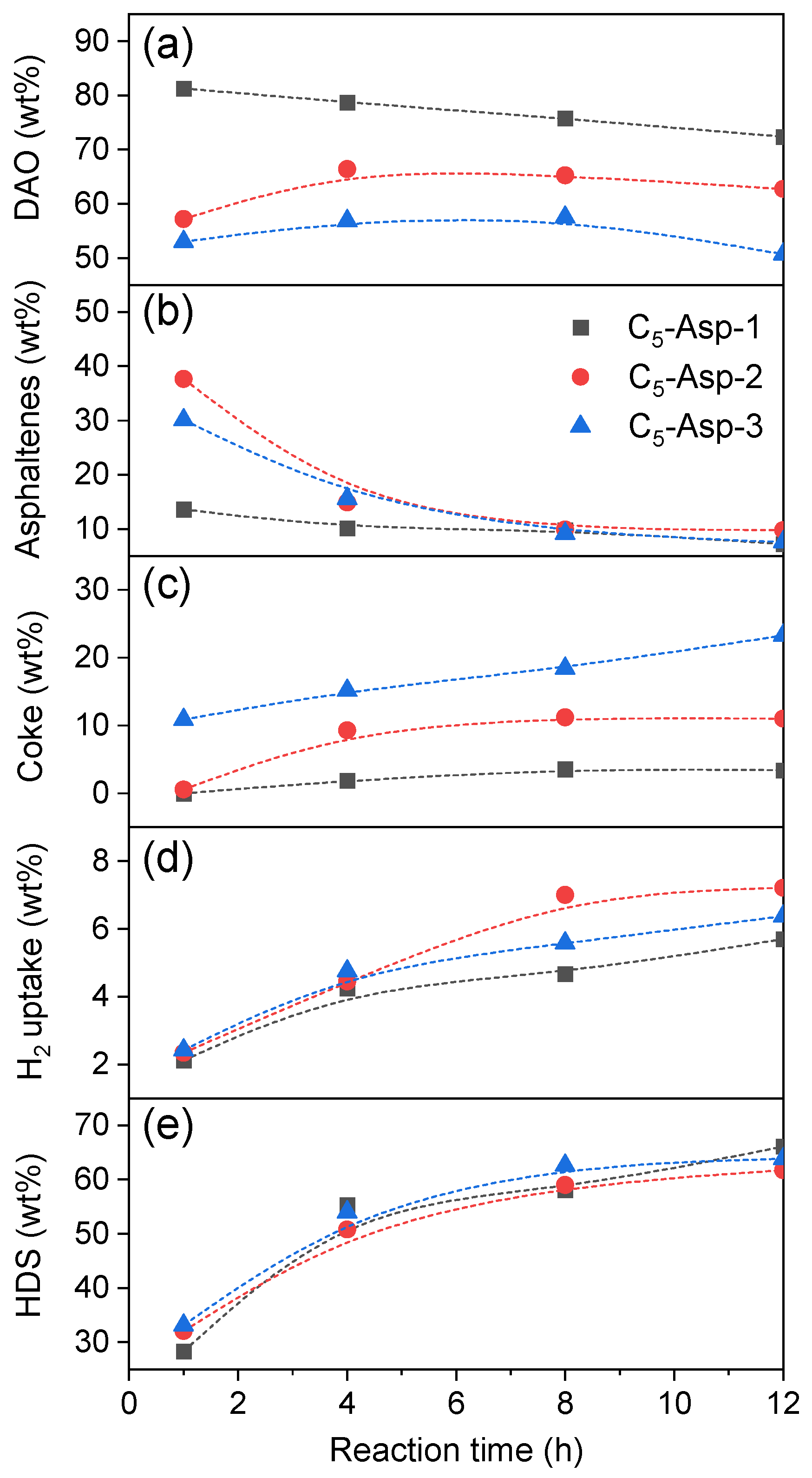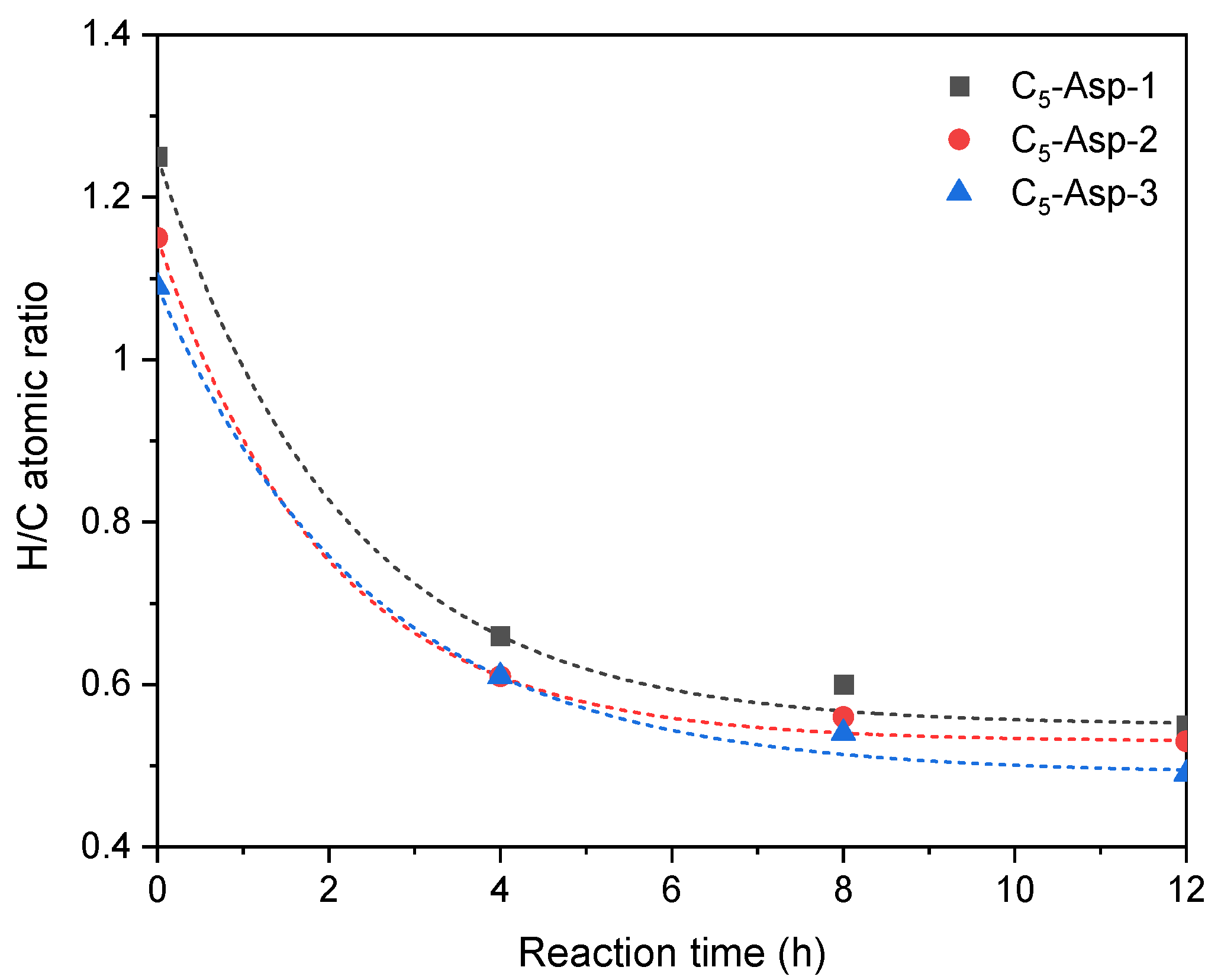Hydrocracking of C5-Isolated Asphaltene and Its Fractions in Batch and Semi-Batch Reactors
Abstract
:1. Introduction
2. Materials and Methods
2.1. Materials
2.2. Experimental Section
2.3. Characterization of Products
3. Results and Discussion
3.1. Non-Catalytic and Catalytic Hydrocracking of C5-Asp in the Batch Reactor
3.2. Hydrocracking of C5-Asp in the Semi-Batch Reactor at 410 °C
3.3. Catalytic Hydrocracking of Asphaltene Subfractions in the Semi-Batch Reactor at 410 °C
3.4. Properties of Coke Produced from Catalytic Hydrocracking of Asphaltene Subfractions
4. Conclusions
Author Contributions
Funding
Conflicts of Interest
References
- Speight, J.G. New approaches to hydroprocessing. Catal. Today 2004, 98, 55–60. [Google Scholar] [CrossRef]
- Rana, M.S.; Sámano, V.; Ancheyta, J.; Diaz, J.A.I. A review of recent advances on process technologies for upgrading of heavy oils and residua. Fuel 2007, 86, 1216–1231. [Google Scholar] [CrossRef]
- Matsumura, A.; Kondo, T.; Sato, S.; Saito, I.; de Souza, W.F. Hydrocracking Brazilian Marlim vacuum residue with natural limonite. Part 1: Catalytic activity of natural limonite. Fuel 2005, 84, 411–416. [Google Scholar] [CrossRef]
- Matsumura, A.; Sato, S.; Kondo, T.; Saito, I.; de Souza, W.F. Hydrocracking Brazilian Marlim vacuum residue with natural limonite. Part 2: Experimental cracking in a slurry-type continuous reactor. Fuel 2005, 84, 417–421. [Google Scholar] [CrossRef]
- Gray, M.R.; McCaffrey, W.C. Role of chain reactions and olefin formation in cracking, hydroconversion, and coking of petroleum and bitumen fractions. Energy Fuels 2002, 16, 756–766. [Google Scholar] [CrossRef]
- Du, H.; Liu, D.; Li, M.; Wu, P.; Yang, Y. Effects of the temperature and initial hydrogen pressure on the isomerization reaction in heavy oil slurry-phase hydrocracking. Energy Fuels 2015, 29, 626–633. [Google Scholar] [CrossRef]
- Du, H.; Liu, N.; Liu, H.; Gao, P.; Lv, R.; Li, M.; Lou, B.; Yang, Y. Role of hydrogen pressure in slurry-phase hydrocracking of Venezuela heavy oil. Energy Fuels 2015, 29, 2104–2110. [Google Scholar] [CrossRef]
- Mullins, O.C.; Sheu, E.Y.; Hammami, A.; Marshall, A.G. Asphaltenes, Heavy Oils, and Petroleomics; Springer: New York, NY, USA, 2010. [Google Scholar]
- Ancheyta, J.; Trejo, F.; Rana, M.S. Asphaltenes Chemical Transformation during Hydroprocessing of Heavy Oils; CRC Press–Taylor & Francis Group: New York, NY, USA, 2009. [Google Scholar]
- Christopher, J.; Sarpal, A.S.; Kapur, G.S. Chemical structure of bitumen-derived asphaltenes by nuclear magnetic resonance spectroscopy and X-ray diffractometry. Fuel 1996, 75, 999–1008. [Google Scholar] [CrossRef]
- Absi-Halabi, M.; Stanislaus, A.; Trimm, D.L. Coke formation on catalysts during the hydroprocessing of heavy oils. Appl. Catal. 1991, 72, 193–215. [Google Scholar] [CrossRef]
- Marchal, C.; Abdessalem, E.; Tayakout-Fayolle, M.; Uzio, D. Asphaltene diffusion and adsorption in modified NiMo alumina catalysts followed by ultraviolet (UV) spectroscopy. Energy Fuels 2010, 24, 4290–4300. [Google Scholar] [CrossRef]
- Faus, F.M.; Grange, P.; Delmon, B. Influence of asphaltene deposition on catalytic activity of cobalt molybdenum on alumina catalysts. Appl. Catal. 1984, 11, 281–293. [Google Scholar] [CrossRef]
- Ancheyta, J.; Centeno, G.; Trejo, F.; Marroquin, G. Changes in asphaltene properties during hydrotreating of heavy crudes. Energy Fuels 2003, 17, 1233–1238. [Google Scholar] [CrossRef]
- Trejo, F.; Ancheyta, J. Kinetics of asphaltenes conversion during hydrotreating of Maya crude. Catal. Today 2005, 109, 99–103. [Google Scholar] [CrossRef]
- Trejo, F.; Ancheyta, J.; Centeno, G.; Marroquin, G. Effect of hydrotreating conditions on Maya asphaltenes composition and structural parameters. Catal. Today 2005, 109, 178–184. [Google Scholar] [CrossRef]
- Ancheyta, J.; Centeno, G.; Trejo, F. Asphaltene characterization as function of time on-stream during hydroprocessing of Maya crude. Catal. Today 2005, 109, 162–166. [Google Scholar] [CrossRef]
- Goncalve, M.L.A.; Ribeiro, D.A.; Teixeira, A.M.R.F.; Teixeira, M.A.G. Influence of asphaltenes on coke formation during the thermal cracking of different Brazilian distillation residues. Fuel 2007, 86, 619–623. [Google Scholar] [CrossRef]
- Wang, J.; Anthony, E.J. A study of thermal-cracking behavier of asphaltenes. Chem. Eng. Sci. 2003, 58, 157–162. [Google Scholar] [CrossRef]
- Martinez, M.T.; Benito, A.M.; Callejas, M.A. Thermal cracking of coal residues: Kinetics of asphaltene decomposition. Fuel 1997, 76, 871–877. [Google Scholar] [CrossRef]
- Rahmani, S.; Gray, M.R. Dependence of molecular kinetics of asphaltene cracking on chemical composition. Pet. Sci. Technol. 2007, 25, 141–152. [Google Scholar] [CrossRef]
- Nguyen, N.T.; Park, S.; Jung, J.; Cho, J.; Lee, C.W.; Park, Y.-K. Comparative reactivity between thermal and catalytic hydrocracking of vacuum residue: Effect of asphaltenes. J. Ind. Eng. Chem. 2018, 61, 32–38. [Google Scholar] [CrossRef]
- Akmaz, S.; Gurkaynak, M.A.; Yasar, M. The effect of temperature on the molecular structure of Raman asphaltenes during pyrolysis. J. Anal. Appl. Pyrolysis 2012, 96, 139–145. [Google Scholar] [CrossRef]
- Zhao, Y.; Wei, F.; Yu, Y. Effects of reaction time and temperature on carbonization in asphaltene pyrolysis. J. Petro. Sci. Eng. 2010, 74, 20–25. [Google Scholar] [CrossRef]
- Douda, J.; Alvarez, R.; Bolanos, J.N. Characterization of Maya asphaltene and maltene by mean of pyrolysis application. Energy Fuels 2008, 22, 2619–2628. [Google Scholar] [CrossRef]
- Zhang, C.; Lee, C.W.; Keogh, R.A.; Demirel, B.; Davis, B.H. Thermal and catalytic conversion of asphaltenes. Fuel 2001, 80, 1131–1146. [Google Scholar] [CrossRef]
- Yasar, M.; Trauth, D.M.; Klein, M.T. Asphaltene and resid pyrolysis. 2. The effect of reaction environment on pathways and selectivities. Energy Fuels 2001, 15, 504–509. [Google Scholar] [CrossRef]
- Rezaei, H.; Liu, X.; Ardakani, S.J.; Smith, K.J.; Bricker, M. A study of Cold Lake vacuum residue hydroconversion in batch and semi-batch reactors using unsupported MoS2 catalysts. Catal. Today 2010, 150, 244–254. [Google Scholar] [CrossRef]
- Otiz-moreno, H.; Ramirez, J.; Sanchez-minero, F.; Cuevas, R.; Ancheyta, J. Hydrocracking of Maya crude oil in a slurry-phase batch reactor. II. Effect of catalyst load. Fuel 2014, 130, 263–272. [Google Scholar] [CrossRef]
- Martinez-grimaldo, H.; Otiz-moreno, H.; Sanchez-minero, F.; Ramirez, J.; Cuevas-garcia, R.; Ancheyta, J. Hydrocracking of Maya crude oil in a slurry-phase batch reactor. II. Effect of reaction temperature. Catal. Today 2014, 130, 269–272. [Google Scholar] [CrossRef]
- Panariti, N.; Del Bianco, A.; Del Piero, G.; Marchionna, M. Petroleum residue upgrading with dispersed catalyst: Part 1. Catalysts activity and selectivity. Appl. Catal. A Gener. 2000, 204, 203–213. [Google Scholar] [CrossRef]
- Kang, K.H.; Nguyen, N.T.; Seo, P.W.; Seo, H.; Kim, G.T.; Kang, N.; Lee, C.W.; Han, S.J.; Chung, M.-C.; Park, S. Slurry-phase hydrocracking of heavy oil over Mo precursors: Effect of triphenylphosphine ligands. J. Catal. 2020, 384, 106–121. [Google Scholar] [CrossRef]
- Miki, Y.; Yamadaya, S.; Oba, M.; Sugimoto, Y. Role of catalyst in hydrocracking of heavy oil. J. Catal. 1983, 83, 371–383. [Google Scholar] [CrossRef]
- Trejo, F.; Centeno, G.; Ancheyta, J. Precipitation, fractionation and characterization of asphaltenes from heavy and light crude oils. Fuel 2004, 83, 2169–2175. [Google Scholar] [CrossRef]
- Kaminski, T.J.; Fogler, H.S.; Wolf, N.; Wattana, P.; Mairal, A. Classification of asphaltenes via fractionation and the effect of heteroatom content on dissolution kinetics. Energy Fuels 2000, 14, 25–30. [Google Scholar] [CrossRef]
- Nguyen, N.T.; Kang, K.H.; Lee, C.W.; Kim, G.T.; Park, S.; Park, Y.-K. Structure comparison of asphaltene aggregates from hydrothermal and catalytic hydrothermal cracking of C5-isolated asphaltene. Fuel 2019, 235, 677–686. [Google Scholar] [CrossRef]
- Bartholdy, J.; Andersen, S.I. Changes in asphaltene stability during hydrotreating. Energy Fuels 2000, 14, 52–55. [Google Scholar] [CrossRef]
- Buch, L.; Groenzin, H.; Buenrostro-Gonzalez, E.; Andersen, S.I.; Lira-Galeana, C.; Mullins, O.C. Molecular size of asphaltene fractions obtained from residuum hydrotreatment. Fuel 2003, 82, 1075–1084. [Google Scholar] [CrossRef]
- Zou, R.; Liu, L.; Yen, T.F.; Chilingarian, G.V. Asphaltenes and Asphalts, Vol 1; Elsevier Science B.V: New York, NY, USA, 1994; p. 339. [Google Scholar]
- Callejas, M.A.; Martínez, M.T. Hydroprocessing of a Maya residue. 1. Intrinsic kinetics of asphaltene removal reactions. Energy Fuels 2000, 14, 1304–1308. [Google Scholar] [CrossRef]
- Seki, H.; Kumata, F. Structural change of petroleum asphaltenes and resins by hydrodemetallization. Energy Fuels 2000, 14, 980–985. [Google Scholar] [CrossRef]
- Li, C.; Han, Y.; Yang, T.; Deng, W. Preliminary study on the influence of catalyst dosage on coke formation of heavy oil slurry-bed hydrocracking. Fuel 2020, 270, 117489. [Google Scholar] [CrossRef]
- Rezaei, H.; Smith, K.J. Catalyst deactivation in slurry-phase residue hydroconversion. Energy Fuels 2013, 27, 6087–6097. [Google Scholar] [CrossRef]
- Mullins, O.C. The modified Yen model. Energy Fuels 2010, 24, 2179–2207. [Google Scholar] [CrossRef]
- Han, S.J.; Kim, S.K.; Hwang, A.; Kim, S.; Hong, D.-Y.; Kwak, G.; Jun, K.-W.; Kim, Y.T. Non-oxidative dehydroaromatization of methane over Mo/H-ZSM-5 catalysts: A detailed analysis of the reaction regeneration cycle. Appl. Catal. B 2019, 241, 305–318. [Google Scholar] [CrossRef]









| Properties | C5-Asp | C5-Asp-1 | C5-Asp-2 | C5-Asp-3 |
|---|---|---|---|---|
| C (wt.%) | 82.1 | 81.4 | 81.6 | 81.5 |
| H (wt.%) | 8.1 | 8.5 | 7.8 | 7.4 |
| N (wt.%) | 1.0 | 0.8 | 1.1 | 1.2 |
| S (wt.%) | 7.2 | 6.7 | 7.4 | 7.9 |
| H/C atomic ratio | 1.18 | 1.25 | 1.15 | 1.09 |
| Ni (wppm) | 170 | 100 | 210 | 280 |
| V (wppm) | 810 | 480 | 990 | 1300 |
| MCR (wt.%) | 48.3 | 39.6 | 51.4 | 57.6 |
© 2020 by the authors. Licensee MDPI, Basel, Switzerland. This article is an open access article distributed under the terms and conditions of the Creative Commons Attribution (CC BY) license (http://creativecommons.org/licenses/by/4.0/).
Share and Cite
Nguyen, N.T.; Kang, K.H.; Seo, P.W.; Kang, N.; Pham, D.V.; Ahn, C.; Kim, G.T.; Park, S. Hydrocracking of C5-Isolated Asphaltene and Its Fractions in Batch and Semi-Batch Reactors. Energies 2020, 13, 4444. https://doi.org/10.3390/en13174444
Nguyen NT, Kang KH, Seo PW, Kang N, Pham DV, Ahn C, Kim GT, Park S. Hydrocracking of C5-Isolated Asphaltene and Its Fractions in Batch and Semi-Batch Reactors. Energies. 2020; 13(17):4444. https://doi.org/10.3390/en13174444
Chicago/Turabian StyleNguyen, Ngoc Thuy, Ki Hyuk Kang, Pill Won Seo, Narae Kang, Duy Van Pham, Chiwoong Ahn, Gyoo Tae Kim, and Sunyoung Park. 2020. "Hydrocracking of C5-Isolated Asphaltene and Its Fractions in Batch and Semi-Batch Reactors" Energies 13, no. 17: 4444. https://doi.org/10.3390/en13174444
APA StyleNguyen, N. T., Kang, K. H., Seo, P. W., Kang, N., Pham, D. V., Ahn, C., Kim, G. T., & Park, S. (2020). Hydrocracking of C5-Isolated Asphaltene and Its Fractions in Batch and Semi-Batch Reactors. Energies, 13(17), 4444. https://doi.org/10.3390/en13174444








